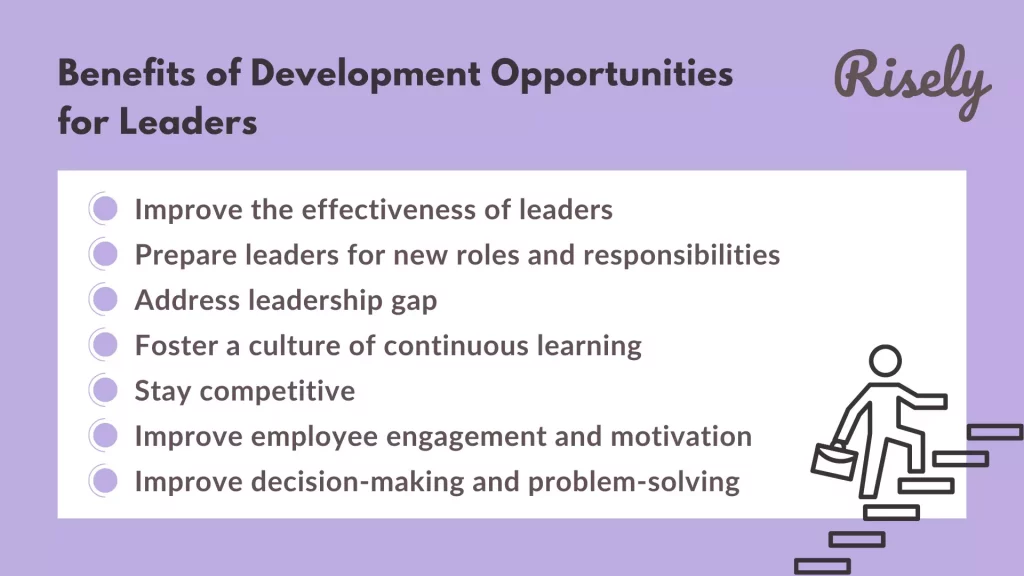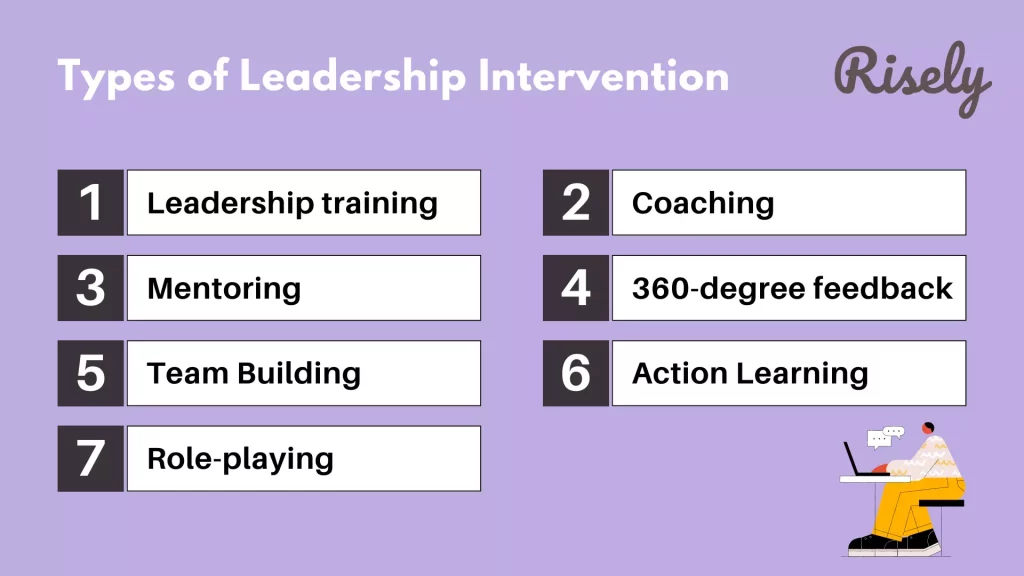Importance Of Development Opportunities For Leaders: 7 Benefits
Welcome to our blog development opportunities for leaders! In today’s fast-paced and ever-changing business landscape, it’s more important than ever for leaders to learn and grow to stay ahead of the curve constantly. Whether you’re a new manager looking to build your skills, or an experienced leader looking to take your career to the next level, countless opportunities are available to help you reach your goals. In this blog, we’ll take a look at some of the development opportunities for leaders, including training programs, mentorship, networking events, and more based on their experience. We’ll also explore how to make the most of these opportunities and how to set yourself up for success. Let’s explore!What is Leadership Development?
Leadership development refers to the process of improving the skills and capabilities of leaders within an organization. This can include training and education on various leadership topics, coaching and mentoring, and opportunities for leaders to take on new responsibilities and challenges. The goal of leadership development is to improve the performance and productivity of the organization by strengthening its leaders’ capabilities. Leadership development opportunities can take many forms, such as classroom training, online courses, one-on-one coaching, mentoring, action learning, job rotation, networking, and professional development. Depending on the organization’s needs, it can be targeted to new, mid-career, or senior leaders. The development opportunities should be tailored to the individual’s unique needs and goals and integrated with the organization’s overall strategy and culture.What is the Benefits of leadership development opportunities for leaders?

- Improve the effectiveness of leaders: By providing training and education on various leadership topics, leaders can develop the skills and knowledge they need to be more effective in their roles, leading to improved team performance and productivity.
- Prepare leaders for new roles and responsibilities: By providing development opportunities for leaders, such as job rotation and action learning, leaders can gain exposure to different roles and responsibilities within the team, which can help them prepare for more advanced leadership roles.
- Address leadership gaps: Through development opportunities for leaders, they can identify and address gaps in leadership skills and knowledge within the teams, which can help ensure that the teams have the leadership capacity to achieve their goals.
- Foster a culture of continuous learning and development: By providing development opportunities to leaders, it creates a culture that values learning and development, which can help to attract and retain top talent.
- Stay competitive: In a rapidly changing business environment, teams need leaders with the skills and knowledge to adapt and lead the company through challenges and opportunities. Leaders can ensure that they are equipped to navigate a constantly changing business landscape by investing in leadership development.
- Improve employee engagement and motivation: When leaders are better equipped to lead and make better decisions, employees engagement and motivation is more likely to be high.
- Improve decision-making and problem-solving: By providing development opportunities to leaders, skills such as action learning, decision-making, and problem-solving skills are developed, which are essential to lead the organization through challenges.
What is Leadership Management?
Leadership management refers to the process of managing and developing the leaders within an organization. It encompasses various activities, including identifying and developing leadership talent, assessing and evaluating leadership performance, and providing opportunities for leaders to improve their skills and capabilities. One of the critical components of leadership management is the identification and development of leadership talent. This can involve assessing the leadership capabilities of current employees and providing opportunities for them to develop the skills and knowledge they need to be effective leaders. Another critical aspect of leadership management is assessing and evaluating leaders’ performance. This can involve gathering feedback from multiple sources, such as peers, subordinates, and superiors, and using that feedback to identify areas for improvement. It also includes setting and evaluating leadership goals and providing regular performance evaluations. Leadership management also includes creating opportunities for leaders to improve their skills and capabilities. This can include providing training and education on various leadership topics and allowing leaders to take on new responsibilities and challenges.Other Interesting Reads
Understanding Leadership Intervention
Leadership intervention refers to a program or strategy to improve leaders’ effectiveness within an organization leading to various growth opportunities. This can include training, coaching, mentoring, or other forms of support to help leaders develop the skills and knowledge they need to be successful. A leadership intervention aims to improve the organization’s performance and productivity by strengthening its leaders’ capabilities.Types of Leadership Interventions
Many leadership interventions can be used to enhance effectiveness and growth opportunities for leaders within the organization. Some examples include:
- Leadership training: This intervention involves providing leaders with various leadership skills, such as communication, decision-making, and problem-solving.
- Coaching: This type of intervention involves working one-on-one with a leader to help them identify areas for improvement and develop a plan to address those areas.
- Mentoring: This type of intervention involves pairing a leader with an experienced mentor who can provide guidance and support as the leader navigates their role.
- 360-degree feedback: This type of intervention involves gathering feedback from multiple sources (e.g., peers, subordinates, superiors) about a leader’s performance and using that feedback to identify areas for improvement.
- Team-building: This type of intervention aims to improve the effectiveness of a team by addressing issues such as communication, conflict resolution, and goal alignment.
- Action learning: This type of intervention is a problem-solving approach in which leaders work through real-world challenges as a team, learning from the process and applying the solution to improve their performance.
- Role-playing: This type of intervention is a simulation method in which leaders are placed in simulated situations and are given feedback on their performance.
Developmental interventions examples for Senior professionals
- Board membership: Senior professionals can gain valuable experience and insights by serving on the board of directors of a company or non-profit organization. This can provide them with exposure to different industries and business models.
- Executive education: Executive education programs are designed specifically for senior leaders and can help them stay up-to-date on the latest management practices and trends.
- Peer networks: Joining a peer network can allow senior professionals to share best practices and gain insights from other leaders in their field. These networks can be informal or formal and can be industry-specific or cross-industry.
- Succession planning: Senior professionals can play a key role in mentoring and developing the next generation of leaders within the organization. This can include creating a mentorship program, providing coaching and feedback, and identifying high-potential employees for leadership development.
Developmental interventions examples for mid-career professionals
- Professional certification programs: Mid-career professionals can enhance their skills and credentials by obtaining professional certifications.
- Job rotation: Job rotation programs allow mid-career professionals to gain experience in different areas of the company. This can be a great way to broaden their skill set and gain a better understanding.
- Stretch assignments: They are challenging tasks given to employees to help them develop new skills and capabilities. These assignments can be short-term projects or temporary roles in different departments.
- Executive coaching: Executive coaching can be a valuable development intervention for mid-career professionals. A coach can help the individual to identify areas for improvement, set goals, and develop a plan to achieve them.
- Professional development courses: Mid-career professionals can continue to learn and develop new skills through online or in-person professional development courses, such as data analysis, digital marketing, or programming.
Developmental interventions examples for new professionals
- Onboarding programs: New professionals can benefit from comprehensive onboarding programs that introduce them to the company’s culture, policies, and procedures. These programs can also provide new hires with the necessary training and resources to perform their job effectively.
- Job shadowing: It allows new professionals to observe and learn from experienced colleagues in their field. This can give them a better understanding the company’s processes and expectations.
- Mentorship: A mentorship program can be a valuable development intervention for new professionals, as it can provide them with guidance and support as they navigate their new roles. A mentor can also share their insights and experience with mentees and help them develop their skills.
- Cross-functional team assignments: Assigning new professionals to cross-functional teams can expose them to different parts of the organization and broaden their skill set.
Conclusion
In conclusion, countless development opportunities are available for leaders at all levels of their careers. Whether you are a new manager, a mid-career professional, or a senior leader, there are many ways to enhance your skills, gain new insights, and take your career to the next level. We hope this blog has given you a better understanding of the development opportunities available and how to make the most of them. Remember, the key to success as a leader is being open to learning and growth and actively seeking development opportunities.Prepare yourself to keep growing!
Grab the free growth mindset toolkit to keep progressing at every stage of your career
FAQs
Which development goals are good for leadership growth opportunities?
Development opportunities for leaders include mentorship, leadership workshops, skill-building programs, cross-functional projects, feedback sessions, and executive coaching to enhance their managerial abilities and professional growth.
Which development goals are good for leadership growth opportunities
Effective development goals for leadership growth include:
Improving communication skills.
Fostering team collaboration.
Enhancing decision-making abilities.
Nurturing emotional intelligence.
Adapting to change with agility.
Improving communication skills.
Fostering team collaboration.
Enhancing decision-making abilities.
Nurturing emotional intelligence.
Adapting to change with agility.
Other Related Blogs
Building an Ultimate Leadership Development Action Plan
How to Build a Leadership Development Action Plan? Having a strong Leadership Development Action Plan is more critical than ever in today’s evolving business world. Whether you’re looking to drive…
Talking Internal Career Mobility with Dr. Edie Goldberg
Talking Internal Career Mobility with Dr. Edie Goldberg What do employees want? As per the LinkedIn Learning Report, the answer seems to be professional growth. Employees are willing to undergo…
Experiential Learning Approaches with Janis Cooper
Experiential Learning Approaches with Janis Cooper Have you heard of leadership development programs that include horses? If not, you are about to! Join Ashish and Janis Cooper in an engaging…
8 Must Know Learning and Development Specialist Interview Questions
Read the blog to get practical tips on the most common Learning and Development Specialist interview questions, including sample answers. It is crafted to give you the confidence to highlight…


